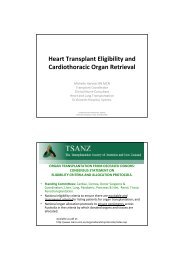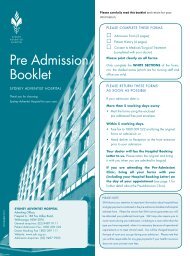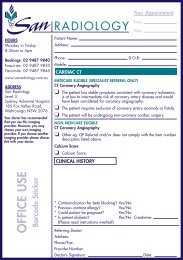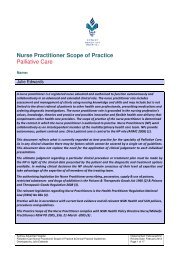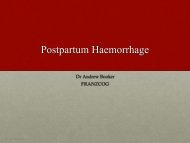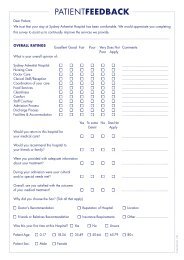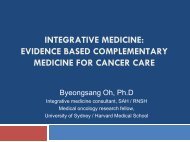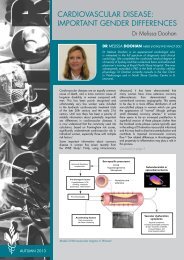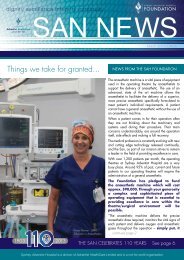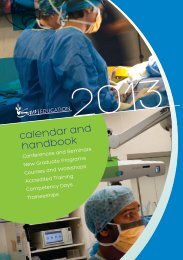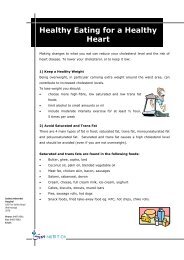Breast Surgery Booklet - Sydney Adventist Hospital
Breast Surgery Booklet - Sydney Adventist Hospital
Breast Surgery Booklet - Sydney Adventist Hospital
You also want an ePaper? Increase the reach of your titles
YUMPU automatically turns print PDFs into web optimized ePapers that Google loves.
pre invasive cancer generally did not have lymph nodesremoved. Sentinel lymph node biopsy is a technique thathas been developed over the last ten years, and requiresthe removal of only one or a few lymph nodes to determineif the breast cancer has spread.Prior to a sentinel lymph node biopsy a lymphoscintigram(LSG) is done, either the day before or on the morning ofsurgery. This involves 3-4 injections of a small amountof radioactive fluid around the cancer in the breast. Theinjections are sometimes given around the nipple, andcan be painful. A special camera tracks the radioactivefluid as it travels through the lymph channels and arrivesat the lymph node(s) receiving fluid directly from thecancer site, where it concentrates. These may be locatedin the armpit, between the ribs or in the neck, and aremarked on your skin to indicate the sentinel node(s). Thisprocedure takes at least 2-3 hours.During surgery your surgeon will inject a blue dye (PatentBlue V – please note there is a 0.1-0.5% risk of allergicreaction to this dye) around the cancer, which flows inexactly the same way as the radioactive fluid did. Yoursurgeon will operate at the site where the sentinel node(s)have been marked, looking for the blue dye in a lymphchannel as a guide to where the lymph node is located.Your surgeon will also use a radiation detection probeto help find the radioactive sentinel node(s). There is avery small level of radiation involved, and no risk to yourgeneral health.Once the sentinel node(s) have been located, thosefrom the armpit are immediately tested in a pathologylaboratory for the presence of cancer cells. If cells arefound, your surgeon will then usually remove all the lymphnodes from the armpit. It is very important to find out howmany lymph nodes contain cancer, and to get rid of allthe cancer from the armpit at this time. If there is only asmall amount of cancer in the sentinel node then furthersurgery to the nodes may not be necessary.PAGE 11
The lymph nodes in between the ribs, near the breastbone, are called “internal mammary” lymph nodes. Aseparate incision is often needed in order to removesentinel node(s) from this area, and this can be painfulafter surgery, as the muscle in between the ribs has tobe cut in order to find these lymph nodes. The internalmammary lymph nodes are not tested immediately, unlikethose from the armpit, and your surgeon won’t removeall the lymph nodes in between the ribs. This has shownto be of no benefit to patients and can cause seriouscomplications. If necessary, the area may be treated withradiotherapy at a later date.The immediate testing of the armpit sentinel nodes is notthe most accurate form of testing, however it does enablesurgeons to minimise the number of operations required.More accurate testing is done on the lymph nodesfollowing surgery, and pathologists use special techniquesto detect very low numbers of cancer cells. These teststake about four to five working days to get results, andthis process can spare the unnecessary removal of all thelymph nodes in the armpit.REMOVAL OF ALL THE LYMPH NODES IN THEARMPITThis part of the operation is called an “axillary clearance”or “lymphadenectomy” or “node dissection”.If an axillary dissection is performed, a drainage tube willbe placed into the space created. The drain is usually ahollow pipe with a number of holes on the side, and willlie in the wound cavity, coming out from the skin somedistance from the operation incision, and will be connectedto a container. It is needed to collect any fluid that buildsup in the space created by surgery. Your drain will stay infor 7 – 10 days (and sometimes longer), however the exactnumber varies between patients and also between doctors.Nearly all patients go home with the drain still in placePAGE 12
and have nursing care continued at home. This is themain inconvenience following armpit surgery. Another sideeffect is a change in sensation around the armpit and alsoin the upper arm. A major long-term concern followingthis surgery is the development of lymphoedema, whichcan affect not only the arm but also the breast and chestwall. Lymphoedema is discussed in more detail later inthis booklet.PAGE 13
ADMISSION AND SURGERYThe first point of contact with the hospital after your doctorhas organised surgery may be the Pre Admission Clinic(PAC) or a telephone call from a Patient Navigator.Patient Navigators (PN) are nurses whose job is to helpbreast cancer patients and their families through everystep of their management.The Pre-Admission Clinic (PAC) is where:• Tests ordered by your doctor are completed (thesemay be done a week before admission, either at thePAC or Doctor’s choice of location). These routinetests will generally include blood tests, x-rays and anelectrocardiograph (ECG - a trace of your heartbeat).• A consultation with an anaesthetist may be organisedREMEMBERTake your usualmorning medicationsas instructed by yourDoctorDo not take Diabeticmedications or bloodthinning medications(warfarin, aspirin,clopidogrel) unlessadvised by yourDoctorWear clean, freshunderwear andclothes on themorning of youroperation• You can organise support required following discharge(PAC staff can coordinate this)• Your observations are recorded including: bloodpressure, pulse, temperature, height and weight• The hospital routine will be explained to you• A special sponge will be provided for you to shower withon the morning of surgery. Please DO NOT use powderor deodorant the morning of your surgery, or shave orwax under your arm.If you do not attend the PAC, these items will be attendedto when you are admitted.Your anticipated length of stay will depend on yourprocedure(s). Please remember that different peoplePAGE 14
ecover at different rates, so a longer stay does not necessarilymean there is a problem.Most patients are admitted the morning of their surgery.You will generally be admitted via the Day of <strong>Surgery</strong> AdmissionCentre (DOSAC). You will be free to walk around prior to surgery;however, we ask that you not leave this immediate area.Please refer to the pre admission booklet for more specificadmission instructions.Your anaesthetist will see you before your procedure, and willdiscuss the anaesthetic with you in further detail. Once youarrive in the operating theatre, you will be taken into the preop holding area where you will be met by theatre staff. Youroperation will generally take around one to two hours but cantake longer for a number of reasons. It does not necessarilymean there has been a problem.WHAT TO BRING• Toiletries• Glasses• Something to do (ie. crosswords, book to read, etc.)• Pyjamas (generally easier than nightgowns) / dressing gown• Slippers / slip-on shoes to wear whenever you are out of bed• Regular medications in original packaging (staff will administerthese during your stay and return them on discharge)• Any walking aids you may use (with name tag attached)• Signed consent form(s)• All x-rays• CPAP machines for those who use them for sleep apnoeaPAGE 15
• At-home nursing support may be provided by the San’s<strong>Hospital</strong> in the Home (HITH) service, <strong>Sydney</strong> HomeNursing Services (SHNS), or the area health servicepost-acute care team (APAC, PACC).• You may be reviewed by a physiotherapist and giveninformation about appropriate exercises to improve yourmobility after surgery• Gentle exercises on the side of surgery are encouragedas soon as your doctor has advised it is OKREMEMBERIt is important to notethat different doctorshave different routinesfor dressings, drainsand pain relief.Your nurse willexplain what yourdoctor orders for yourparticular admission.Your regular medications will recommence once you havestarted eating.Pain relief following your operation can come in anumber of forms:• PCA – where you control the pain relief at the press of abutton• Intravenous/intramuscular injections• TabletsPlease let staff know if the pain relief provided is notadequate.The Patient Navigators are available to talk throughany concerns you may have. They will also discussthe <strong>Hospital</strong>'s support services and provide you withinformation on our Cancer Support Service at JacarandaLodge. They will also advise on temporary and permanentbreast prostheses following a mastectomy.Our Cancer Support Service at Jacaranda lodge (on site)will be able to assist with additional information. You willreceive a <strong>Breast</strong> Cancer Information Pack prepared byPAGE 17
Cancer Support Centre volunteers. Educational lecturesand <strong>Breast</strong> Cancer support groups are also providedthrough San Cancer Support Services. You may ask anurse to contact them for you, or ask switchboard totransfer you to the Cancer Support Centre via phone. TheSan Cancer Support Centre staff and volunteers routinelyfollow up with a courtesy phone call two to three weeksafter your hospital stay.BEFORE YOU ARE DISCHARGEDIt is important to remember that everybody recovers attheir own rate. These are some of the expectations wehave of your recovery prior to your discharge:• Your pain will be controlled with oral medication• Your wound will be free from infection, and you will havea basic understanding of how to care for it• You will be tolerating a light / normal diet• You will be able to walk along the corridor• If you have a drain you will be shown how it works• If you are going home with a drain, your drain care afterdischarge will be organised before you leave hospital. Ifyou live locally, San nurses will either come to your homeor we will arrange for you to come to the San for draincare. This is managed through HITH (<strong>Hospital</strong> in theHome). If you don’t live locally, we will organise communitynurses to visit you at your home for drain care. The drainwill be removed according to your doctor’s instructions.PAGE 18
DAY OF DISCHARGEStaff will return any valuables you have locked away and anymedications you brought to <strong>Hospital</strong>. Arrangements madefor home support will now have been confirmed and thesewill be explained to you. Ensure you know when you need tovisit your doctor.Analgesics and possibly antibiotics will be provided for useat home.ONCE YOU ARE AT HOMEDISCHARGE TIMEDischarge is by10.00am.Please see the NursingUnit Manager if youare having difficulty invacating your room bythis time.As with any surgery, there is a potential risk ofcomplications.These may include:• Infection in the wound site• Bleeding from the wound site• Collection of fluid in the cavity under your armCARE OF YOUR WOUNDCare of a wound post surgery is important in order to preventinfection. Infections can occur if you, or others, touch yourwound with unwashed hands. Always wash your hands, oralternatively use an alcohol hand gel, before you touch yourwound. This is important for patients who have a drain witha bag attached; have a drain that has been cut and bagged;and also for patients who do not have a drain.• Each doctor has their own specific instructions for care ofyour wound(s) on discharge. Make sure you understandyour doctor’s instructions clearly before discharge.PAGE 19
• If a drain is in place, make sure it is well secured tothe skin by an adhesive dressing and tape to preventit pulling at the skin as this causes pain and increasesthe risk of the drain dislodging and infection.• If clothes are irritating the wound apply a soft pad orany other soft dressing between the clothes and yourwound. Change this dressing if it becomes dirty anduse a fresh one each day.The symptoms of an infection include fever, rigors, flulikesymptoms, redness and/or swelling, pus or offensivedischarge and/or an increase in pain.Drains can become blocked which can cause an infection.Drain blockage should be suspected if the flow decreasesdramatically and/or if there is a leakage around the drain.The incidence of complications following breast surgeryis low. Alternatively, if you have concerns regarding yourcondition following surgery, you can discuss this with:• Your Doctor• Patient Navigators Phone:9487 9395• <strong>Hospital</strong> in the Home (HITH) nurse if one is visiting you• Your GP• San Gee Ward Phone:9487 9151• Visit San Emergency DepartmentPAGE 20
LYMPHOEDEMASome women may develop lymphoedema (a swelling in the hand, arm or chest wall)after surgery and / or radiotherapy. It may be very mild, and can develop months, or evenyears after treatment. You should consult your doctor or physiotherapist if you notice anyaggravation of swelling, pain or signs of inflammation such as reddening of the skin. Yourphysiotherapist will discuss this further with you in your follow-up appointment.• Arm lymphoedema occurs to a significant degree in about 10% of patients who havehad a full clearance. The incidence after sentinel node biopsy is about 1-2%We encourage all patients who have had mastectomies and/or full lymph node clearance tosee our lymphoedema specialist physiotherapists a few weeks after discharge.FOLLOW-ON TREATMENTHOW TO PREVENT LYMPHOEDEMA1. Use your arms for normalactivities. Alternate activities.2. Include exercise in your dailylife, 30 to 45 minutes of moderateexercise on most days of the weekis recommended.3. Keep weight and bloodpressure within the normal range.Increased weight is positivelyassociated with increase inlymphoedema.4. Progressive resistance trainingwill improve your ability tocope with normal activities e.gshopping, caring for children, etc.6. Take precautions to avoidscratches, insect bites, or sunburn.7. Treat injury to the armpromptly. If infection develops seeyour doctor.8. Wash and moisturise your skinregularly with strokes from handup towards the shoulder.9. Have injections, blood tests,and blood pressure measures onthe other side or leg.10. Wear loose clothing andjewellery. A tight bra may causeswelling on the chest wall.5. Avoid overheating, no saunas/spas or heat (hot pack) treatmentto that arm/shoulder.PAGE 21
Generally, following surgery for the removal of breastcancer, patients will have follow-on treatment such aschemotherapy or radiation therapy. Some patients mayhave a combination of both. Your doctor will advise whatis the best course of treatment for your individual situationand you may choose to come back to <strong>Sydney</strong> <strong>Adventist</strong><strong>Hospital</strong> for either or both of these ongoing treatments.Some patients do not require any further treatment.SAN DAY INFUSION CENTREChemotherapy treatment is now often given on anoutpatient or day-only patient basis. <strong>Sydney</strong> <strong>Adventist</strong><strong>Hospital</strong> offers a day treatment area where varioustreatments, given over a few hours, can be administered.Specialist oncology nurses administer chemotherapyregimens and bookings are taken from Monday-Friday. Ifovernight stay or weekend treatment is required, patientsmay be admitted to our ‘Poon Oncology Ward’.Other common treatments administered in the Day InfusionCentre are blood transfusions and short drug infusions. Ifyou would like to visit the San Day Infusion Centre or theOncology Ward, please ask one of the staff to arrange atour.<strong>Sydney</strong> <strong>Adventist</strong> <strong>Hospital</strong> runs Chemotherapy Informationsessions. These sessions are held for patients who haverecently started chemotherapy, or are about to commencetreatment, and provide patients with an understanding oftheir treatment and the support services available to them.They are held in the Cancer Support Centre, JacarandaLodge. For further information, please contact (02) 94879061.PAGE 22
RADIATION ONCOLOGY INSTITUERadiotherapy, or radiation therapy, is another commontreatment that is used following breast surgery for cancer.This procedure uses high-energy x-rays to kill the fast growingcancer cells. The most common radiation treatment for breastcancer is external beam radiation therapy. Using a machinecalled a Linear Accelerator, a beam of radiation is directed atthe breast from a number of angles to ensure an even dose tothe treatment area. Radiotherapy is delivered on an outpatientbasis, and a course of radiotherapy would be given five days aweek for five to seven weeks.Once all your follow-on treatment is completed, regularexaminations from your doctor(s) will still be required. Thesemay include physical examinations and mammograms to ensurethe treatment has been successful.SAN PHYSIOTHERAPYSan Physiotherapy offers ongoing backup and support forwomen and men post breast surgery and those living withlymphoedema. Each individual is unique, as is their surgeryand treatment, therefore exercises need to be tailored to theindividual.Studies have shown exercise can assist in:• Decreasing nausea and fatigue associated with cancertreatment• Preventing weight gain associated with chemotherapy –exercise increases lean muscle and decreases body fat• Decreasing duration of future hospitalisation• Decreasing the chance of developing lymphoedema• Improving aerobic fitness, flexibility and balancePAGE 23
San Physiotherapy provides support for breast surgerypatients through a post-surgical follow up visit,lymphoedema prevention and treatment, and both landand water based classes tailored specifically to post-breastsurgery patients. You can contact San Physiotherapy on(02) 9487 9350.COMPLEMENTARY & ALTERNATIVE THERAPIESIn addition to medical treatments, there are a number ofcomplementary and alternative therapies that people withcancer may wish to try. Not all these therapies are safefor breast cancer patients however, so if you are usingcomplementary or alternative therapies please inform yourdoctor before surgery. If you wish to use complementaryor alternative therapies at any stage throughout yourtreatment, keeping your doctor informed will help themprovide the best care for you.The San Cancer Support Centre at Jacaranda Lodge offerstherapies such as meditation, massage, reflexology andacupuncture, and others. Call (02) 9487 9061 or visit www.sah.org.au/cancer-support for more information.PAGE 24
• The San also has a Cancer Council Information Centreon site in the foyer of Level 4, The San Clinic. Brochuresand information are available on various types of cancerand a range of support services available, both at theSan and in the community. Opening hours are Mondayto Thursday, 10:00am to 4:00pm, and Friday 10:00am to2:00pm.• <strong>Breast</strong> Cancer Network Australia (BCNA) is the peaknational organisation for Australians affected by breastcancer, and has an online network of more than 57,000individual members and 294 Member Groups via theirwebsite www.bcna.org.au. It works to ensure thatwomen diagnosed with breast cancer, and their families,receive the very best information, treatment, care andsupport possible, no matter who they are or where theylive.• The <strong>Breast</strong> Cancer Institute NSW also has a veryinformative website, www.bci.org.au, with various factsheets and useful information. There is also a chat linecalled B-mail that will allow you to speak with otherpatients dealing with breast cancer.• National <strong>Breast</strong> and Ovarian Cancer Centre (NBOCC)is Australia's independent national authority andinformation source on breast cancer and ovarian cancer– www.nbcc.org.au.• www.breastlink.com is an American website which hasinformation regarding latest treatments, news items, andgeneral information on breast cancer.PAGE 26
OTHER SAN SERVICESCANCER SUPPORT CENTRE Ph: (02) 9487 9061Located on site in the Jacaranda Lodge buildingThe Cancer Support Centre offers:• Education Lectures• Personal and Familysupport and counselling• Support groups (carer’sand patient groups,including <strong>Breast</strong> Cancerand Young Women with<strong>Breast</strong> Cancer groups)• Meditation• Massage• Acupuncture• ‘Look Good, Feel Better’Program• Information (Library,Audio and Video andInternet Information)• Wig Library• Phone-in and Drop-in• Home Visitation• Bereavement Support• Volunteer TransportSPIRITUAL CARE SERVICES Ph: (02) 9487 9289• Counselling service for inpatients• Arranging pastoral visits from various denominationsJACARANDA LODGE – on site Ph (02) 9487 9066• Low cost accommodation for families of hospitalinpatients or radiation oncology outpatientsPAGE 27
PAGE 28NOTES
Follow up appointmentsAppointment with _____________________________________________Date/Time ___________________________________________________Place ___________________________________________________________________________________ Phone __________________________Appointment with _____________________________________________Date/Time ___________________________________________________Place ___________________________________________________________________________________ Phone __________________________Appointment with _____________________________________________Date/Time ___________________________________________________Place ___________________________________________________________________________________ Phone __________________________Appointment with _____________________________________________Date/Time ___________________________________________________Place ___________________________________________________________________________________ Phone __________________________Appointment with _____________________________________________Date/Time ___________________________________________________Place ___________________________________________________________________________________ Phone __________________________PAGE 29
Follow up appointmentsAppointment with _____________________________________________Date/Time ___________________________________________________Place ___________________________________________________________________________________ Phone __________________________Appointment with _____________________________________________Date/Time ___________________________________________________Place ___________________________________________________________________________________ Phone __________________________Appointment with _____________________________________________Date/Time ___________________________________________________Place ___________________________________________________________________________________ Phone __________________________Appointment with _____________________________________________Date/Time ___________________________________________________Place ___________________________________________________________________________________ Phone __________________________Appointment with _____________________________________________Date/Time ___________________________________________________Place ___________________________________________________________________________________ Phone __________________________PAGE 30
PAGE 31
<strong>Sydney</strong> <strong>Adventist</strong> hospitalGee Ward (Level 11) 9487 9151Jacaranda Lodge 9487 9066Patient Navigators 9487 9395Poon Ward (Level 6) 9487 9651Pre Admission Clinic 9487 9115Radiation Oncology Institute 9487 9300San Cancer Support Centre 9487 9061San Day Infusion Centre 9487 9591San Physiotherapy 9487 9350Social Workers 9487 9660Spiritual Care Services 9487 9289Wound Clinic 9487 9785185 Fox Valley Road, Wahroonga NSW 2076Ph: 02 9487 9111 Fax: 02 9487 9266www.sah.org.au0065/BN/1011/PR



